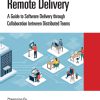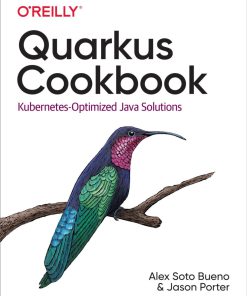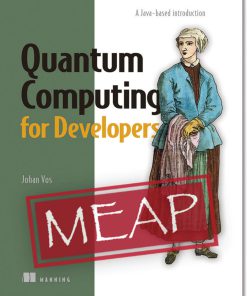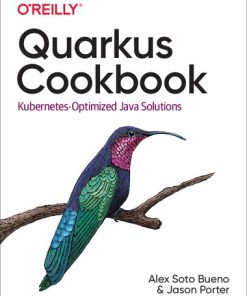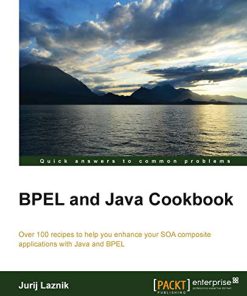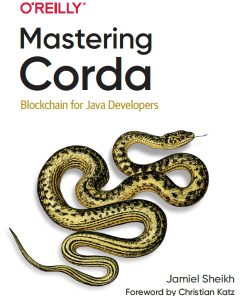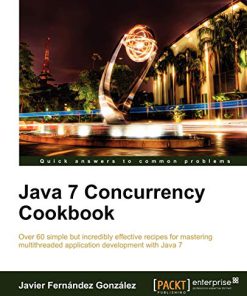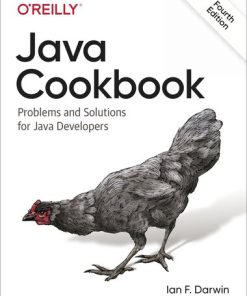Java Cookbook Problems and Solutions for Java Developers 4th Edition by Ian Darwin ISBN 1492072532 9781492072539
$50.00 Original price was: $50.00.$25.00Current price is: $25.00.
Java Cookbook Problems and Solutions for Java Developers 4th Edition by Ian F. Darwin – Ebook PDF Instant Download/Delivery: 1492072532, 9781492072539
Full download Java Cookbook Problems and Solutions for Java Developers 4th Edition after payment
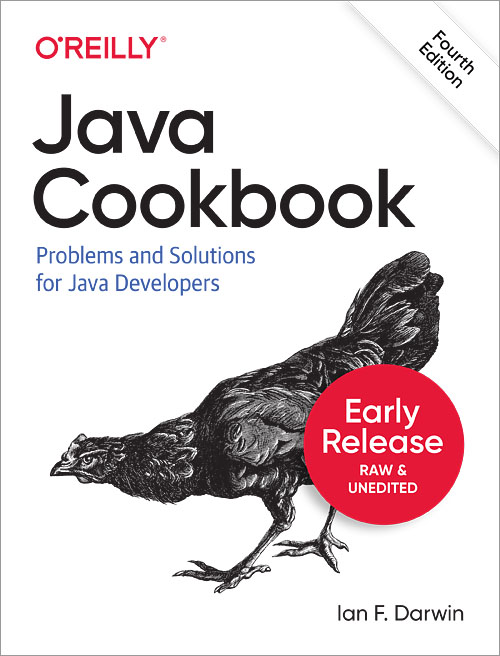
Product details:
ISBN 10: 1492072532
ISBN 13: 9781492072539
Author: Ian F. Darwin
Java continues to grow and evolve, and this cookbook continues to evolve in tandem. With this guide, you’ll get up to speed right away with hundreds of hands-on recipes across a broad range of Java topics. You’ll learn useful techniques for everything from string handling and functional programming to network communication. Each recipe includes self-contained code solutions that you can freely use, along with a discussion of how and why they work. If you’re familiar with Java basics, this cookbook will bolster your knowledge of the language and its many recent changes, including how to apply them in your day-to-day development. This updated edition covers changes through Java 12 and parts of 13 and 14. Recipes include: Methods for compiling, running, and debugging Packaging Java classes and building applications Manipulating, comparing, and rearranging text Regular expressions for string and pattern matching Handling numbers, dates, and times Structuring data with collections, arrays, and other types Object-oriented and functional programming techniques Input/output, directory, and filesystem operations Network programming on both client and server Processing JSON for data interchange Multithreading and concurrency Using Java in big data applications Interfacing Java with other languages.
Java Cookbook Problems and Solutions for Java Developers 4th Table of contents:
1. Getting Started: Compiling and Running Java
1.0. Introduction
1.1. Compiling and Running Java: Standard JDK
1.2. Compiling and Running Java: GraalVM for Better Performance
1.3. Compiling, Running, and Testing with an IDE
1.4. Exploring Java with JShell
1.5. Using CLASSPATH Effectively
1.6. Downloading and Using the Code Examples
1.7. Automating Dependencies, Compilation, Testing, and Deployment with Apache Maven
1.8. Automating Dependencies, Compilation, Testing, and Deployment with Gradle
1.9. Dealing with Deprecation Warnings
1.10. Maintaining Code Correctness with Unit Testing: JUnit
1.11. Maintaining Your Code with Continuous Integration
1.12. Getting Readable Stack Traces
1.13. Finding More Java Source Code
1.14. Finding Runnable Java Libraries
2. Interacting with the Environment
2.0. Introduction
2.1. Getting Environment Variables
2.2. Getting Information from System Properties
2.3. Dealing with Code That Depends on the Java Version or the Operating System
2.4. Using Extensions or Other Packaged APIs
2.5. Using the Java Modules System
3. Strings and Things
3.0. Introduction
3.1. Taking Strings Apart with Substrings or Tokenizing
3.2. Putting Strings Together with StringBuilder
3.3. Processing a String One Character at a Time
3.4. Aligning, Indenting, and Unindenting Strings
3.5. Converting Between Unicode Characters and Strings
3.6. Reversing a String by Word or by Character
3.7. Expanding and Compressing Tabs
3.8. Controlling Case
3.9. Entering Nonprintable Characters
3.10. Trimming Blanks from the End of a String
3.11. Creating a Message with I18N Resources
3.12. Using a Particular Locale
3.13. Creating a Resource Bundle
3.14. Program: A Simple Text Formatter
3.15. Program: Soundex Name Comparisons
4. Pattern Matching with Regular Expressions
4.0. Introduction
4.1. Regular Expression Syntax
4.2. Using Regexes in Java: Test for a Pattern
4.3. Finding the Matching Text
4.4. Replacing the Matched Text
4.5. Printing All Occurrences of a Pattern
4.6. Printing Lines Containing a Pattern
4.7. Controlling Case in Regular Expressions
4.8. Matching Accented, or Composite, Characters
4.9. Matching Newlines in Text
4.10. Program: Apache Logfile Parsing
4.11. Program: Full Grep
5. Numbers
5.0. Introduction
5.1. Checking Whether a String Is a Valid Number
5.2. Converting Numbers to Objects and Vice Versa
5.3. Taking a Fraction of an Integer Without Using Floating Point
5.4. Working with Floating-Point Numbers
5.5. Formatting Numbers
5.6. Converting Among Binary, Octal, Decimal, and Hexadecimal
5.7. Operating on a Series of Integers
5.8. Formatting with Correct Plurals
5.9. Generating Random Numbers
5.10. Multiplying Matrices
5.11. Using Complex Numbers
5.12. Handling Very Large Numbers
5.13. Program: TempConverter
5.14. Program: Number Palindromes
6. Dates and Times
6.0. Introduction
6.1. Finding Today’s Date
6.2. Formatting Dates and Times
6.3. Converting Among Dates/Times, YMDHMS, and Epoch Seconds
6.4. Parsing Strings into Dates
6.5. Difference Between Two Dates
6.6. Adding to or Subtracting from a Date
6.7. Handling Recurring Events
6.8. Computing Dates Involving Time Zones
6.9. Interfacing with Legacy Date and Calendar Classes
7. Structuring Data with Java
7.0. Introduction
7.1. Using Arrays for Data Structuring
7.2. Resizing an Array
7.3. The Collections Framework
7.4. Like an Array, but More Dynamic
7.5. Using Generic Types in Your Own Class
7.6. How Shall I Iterate Thee? Let Me Enumerate the Ways
7.7. Eschewing Duplicates with a Set
7.8. Structuring Data in a Linked List
7.9. Mapping with Hashtable and HashMap
7.10. Storing Strings in Properties and Preferences
7.11. Sorting a Collection
7.12. Avoiding the Urge to Sort
7.13. Finding an Object in a Collection
7.14. Converting a Collection to an Array
7.15. Making Your Data Iterable
7.16. Using a Stack of Objects
7.17. Multidimensional Structures
7.18. Simplifying Data Objects with Lombok or Record
7.19. Program: Timing Comparisons
8. Object-Oriented Techniques
8.0. Introduction
8.1. Object Methods: Formatting Objects with toString(), Comparing with Equals
8.2. Using Inner Classes
8.3. Providing Callbacks via Interfaces
8.4. Polymorphism/Abstract Methods
8.5. Using Typesafe Enumerations
8.6. Avoiding NPEs with Optional
8.7. Enforcing the Singleton Pattern
8.8. Roll Your Own Exceptions
8.9. Using Dependency Injection
8.10. Program: Plotter
9. Functional Programming Techniques: Functional Interfaces, Streams, and Parallel Collections
9.0. Introduction
9.1. Using Lambdas/Closures Instead of Inner Classes
9.2. Using Predefined Lambda Interfaces Instead of Your Own
9.3. Simplifying Processing with Streams
9.4. Simplifying Streams with Collectors
9.5. Improving Throughput with Parallel Streams and Collections
9.6. Using Existing Code as Functional with Method References
9.7. Java Mixins: Mixing in Methods
10. Input and Output: Reading, Writing, and Directory Tricks
10.0. Introduction
10.1. About InputStreams/OutputStreams and Readers/Writers
10.2. Reading a Text File
10.3. Reading from the Standard Input or from the Console/Controlling Terminal
10.4. Printing with Formatter and printf
10.5. Scanning Input with StreamTokenizer
10.6. Scanning Input with the Scanner Class
10.7. Scanning Input with Grammatical Structure
10.8. Copying a File
10.9. Reassigning the Standard Streams
10.10. Duplicating a Stream as It Is Written; Reassigning Standard Streams
10.11. Reading/Writing a Different Character Set
10.12. Those Pesky End-of-Line Characters
10.13. Beware Platform-Dependent File Code
10.14. Reading/Writing Binary Data
10.15. Reading and Writing JAR or ZIP Archives
10.16. Finding Files in a Filesystem-Neutral Way with getResource() and getResourceAsStream()
10.17. Getting File Information: Files and Path
10.18. Creating a New File or Directory
10.19. Changing a File’s Name or Other Attributes
10.20. Deleting a File
10.21. Creating a Transient/Temporary File
10.22. Listing a Directory
10.23. Getting the Directory Roots
10.24. Using the FileWatcher Service to Get Notified About File Changes
10.25. Program: Save User Data to Disk
10.26. Program: Find—Walking a File Tree
11. Data Science and R
11.1. Machine Learning with Java
11.2. Using Data In Apache Spark
11.3. Using R Interactively
11.4. Comparing/Choosing an R Implementation
11.5. Using R from Within a Java App: Renjin
11.6. Using Java from Within an R Session
11.7. Using FastR, the GraalVM Implementation of R
11.8. Using R in a Web App
12. Network Clients
12.0. Introduction
12.1. HTTP/REST Web Client
12.2. Contacting a Socket Server
12.3. Finding and Reporting Network Addresses
12.4. Handling Network Errors
12.5. Reading and Writing Textual Data
12.6. Reading and Writing Binary or Serialized Data
12.7. UDP Datagrams
12.8. URI, URL, or URN?
12.9. Program: TFTP UDP Client
12.10. Program: Sockets-Based Chat Client
12.11. Program: Simple HTTP Link Checker
13. Server-Side Java
13.0. Introduction
13.1. Opening a Server Socket for Business
13.2. Finding Network Interfaces
13.3. Returning a Response (String or Binary)
13.4. Returning Object Information Across a Network Connection
13.5. Handling Multiple Clients
13.6. Serving the HTTP Protocol
13.7. Securing a Web Server with SSL and JSSE
13.8. Creating a REST Service with JAX-RS
13.9. Network Logging
13.10. Setting Up SLF4J
13.11. Network Logging with Log4j
13.12. Network Logging with java.util.logging
14. Processing JSON Data
14.0. Introduction
14.1. Generating JSON Directly
14.2. Parsing and Writing JSON with Jackson
14.3. Parsing and Writing JSON with org.json
14.4. Parsing and Writing JSON with JSON-B
14.5. Finding JSON Elements with JSON Pointer
15. Packages and Packaging
15.0. Introduction
15.1. Creating a Package
15.2. Documenting Classes with Javadoc
15.3. Beyond Javadoc: Annotations/Metadata
15.4. Preparing a Class as a JavaBean
15.5. Archiving with JAR
15.6. Running a Program from a JAR
15.7. Packaging Web Tier Components into a WAR File
15.8. Creating a Smaller Distribution with jlink
15.9. Using JPMS to Create a Module
16. Threaded Java
16.0. Introduction
16.1. Running Code in a Different Thread
16.2. Displaying a Moving Image with Animation
16.3. Stopping a Thread
16.4. Rendezvous and Timeouts
16.5. Synchronizing Threads with the synchronized Keyword
16.6. Simplifying Synchronization with Locks
16.7. Simplifying Producer/Consumer with the Queue Interface
16.8. Optimizing Parallel Processing with Fork/Join
16.9. Scheduling Tasks: Future Times, Background Saving in an Editor
17. Reflection, or “A Class Named Class”
17.0. Introduction
17.1. Getting a Class Descriptor
17.2. Finding and Using Methods and Fields
17.3. Accessing Private Methods and Fields via Reflection
17.4. Loading and Instantiating a Class Dynamically
17.5. Constructing a Class from Scratch with a ClassLoader
17.6. Constructing a Class from Scratch with JavaCompiler
17.7. Performance Timing
17.8. Printing Class Information
17.9. Listing Classes in a Package
17.10. Using and Defining Annotations
17.11. Finding Plug-In-Like Classes via Annotations
17.12. Program: CrossRef
18. Using Java with Other Languages
18.0. Introduction
18.1. Running an External Program from Java
18.2. Running a Program and Capturing Its Output
18.3. Calling Other Languages via javax.script
18.4. Mixing Languages with GraalVM
18.5. Marrying Java and Perl
18.6. Calling Other Languages via Native Code
18.7. Calling Java from Native Code
People also search for Java Cookbook Problems and Solutions for Java Developers 4th:
challenges faced by java developers
why won’t my java program run
how much java is needed for android development
java cookbook 4th edition
java cookbook
Tags:
Ian Darwin,Java Cookbook,Problems,Solutions,Java Developers
You may also like…
Engineering
Android Cookbook Problems and Solutions for Android Developers 2nd Edition Ian F. Darwin
Computers
Quarkus Cookbook Kubernetes Optimized Java Solutions 1st Edition Alex Soto Bueno Jason Porter
Computers - Programming
Quantum Computing for Developers A Java based introduction MEAP V09 Johan Vos
Computers - Programming
Uncategorized
Computers - Programming
Mastering Corda Blockchain for Java Developers 1st Edition Jamiel Sheikh
Uncategorized
Computers - Networking
Java Cookbook Problems and Solutions for Java Developers final release 4th Edition Ian F. Darwin


